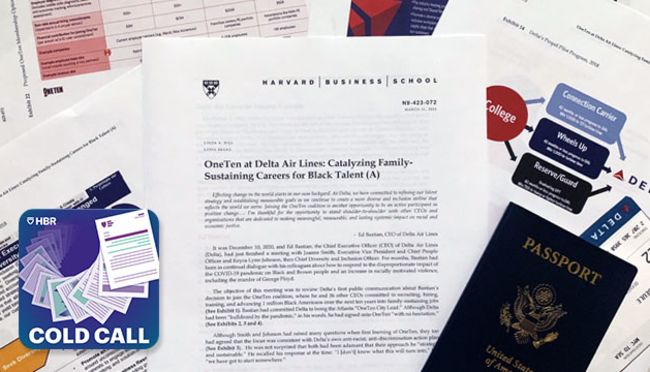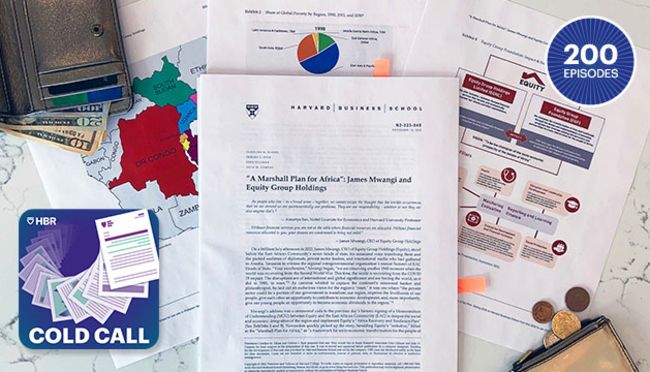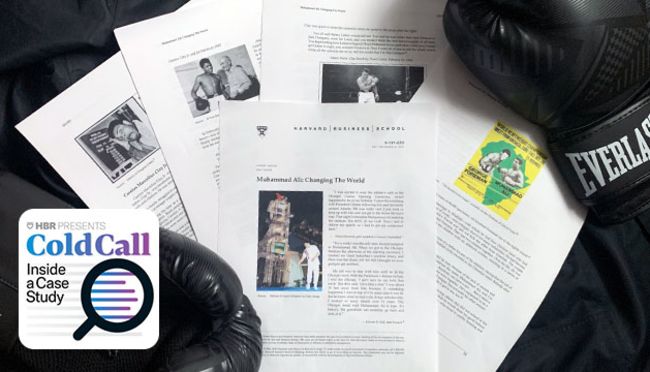System →
→

- 27 Feb 2024
- Research & Ideas
Why Companies Should Share Their DEI Data (Even When It’s Unflattering)
Companies that make their workforce demographics public earn consumer goodwill, even if the numbers show limited progress on diversity, says research by Ryan Buell, Maya Balakrishnan, and Jimin Nam. How can brands make transparency a differentiator?

- 02 Jan 2024
- Cold Call Podcast
Should Businesses Take a Stand on Societal Issues?
Should businesses take a stand for or against particular societal issues? And how should leaders determine when and how to engage on these sensitive matters? Harvard Business School Senior Lecturer Hubert Joly, who led the electronics retailer Best Buy for almost a decade, discusses examples of corporate leaders who had to determine whether and how to engage with humanitarian crises, geopolitical conflict, racial justice, climate change, and more in the case, “Deciding When to Engage on Societal Issues.”

- 02 Jan 2024
- Research & Ideas
10 Trends to Watch in 2024
Employees may seek new approaches to balance, even as leaders consider whether to bring more teams back to offices or make hybrid work even more flexible. These are just a few trends that Harvard Business School faculty members will be following during a year when staffing, climate, and inclusion will likely remain top of mind.

- 21 Nov 2023
- Cold Call Podcast
Cold Call: Building a More Equitable Culture at Delta Air Lines
In December 2020 Delta Air Lines CEO Ed Bastian and his leadership team were reviewing the decision to join the OneTen coalition, where he and 36 other CEOs committed to recruiting, hiring, training, and advancing one million Black Americans over the next ten years into family-sustaining jobs. But, how do you ensure everyone has equal access to opportunity within an organization? Professor Linda Hill discusses Delta’s decision and its progress in embedding a culture of diversity, equity, and inclusion in her case, “OneTen at Delta Air Lines: Catalyzing Family-Sustaining Careers for Black Talent.”

- 21 Nov 2023
- Op-Ed
The Beauty Industry: Products for a Healthy Glow or a Compact for Harm?
Many cosmetics and skincare companies present an image of social consciousness and transformative potential, while profiting from insecurity and excluding broad swaths of people. Geoffrey Jones examines the unsightly reality of the beauty industry.

- 07 Nov 2023
- Research & Ideas
When Glasses Land the Gig: Employers Still Choose Workers Who 'Look the Part'
Is an eyeglass-wearer more likely to be a strong web developer? Employers that use online talent platforms tend to consider profile photos in final hiring decisions, says research by Isamar Troncoso. What's the role of recruiting platforms in preventing bias?

- 31 Oct 2023
- Research & Ideas
Beyond the 'Business Case' in DEI: 6 Steps Toward Meaningful Change
Diversity and inclusion efforts that focus on business outcomes alone rarely address root causes. Jamillah Bowman Williams, a visiting fellow at the Institute for the Study of Business in Global Society, offers tips for companies navigating their next stage of the DEI journey.

- 16 Oct 2023
- HBS Case
Advancing Black Talent: From the Flight Ramp to 'Family-Sustaining' Careers at Delta
By emphasizing skills and expanding professional development opportunities, the airline is making strides toward recruiting and advancing Black employees. Case studies by Linda Hill offer an inside look at how Delta CEO Ed Bastian is creating a more equitable company and a stronger talent pipeline.
.jpg)
- 10 Oct 2023
- Research & Ideas
In Empowering Black Voters, Did a Landmark Law Stir White Angst?
The Voting Rights Act dramatically increased Black participation in US elections—until worried white Americans mobilized in response. Research by Marco Tabellini illustrates the power of a political backlash.

- 26 Sep 2023
- Research & Ideas
Unpacking That Icky Feeling of 'Shopping' for Diverse Job Candidates
Many companies want to bring a wider variety of lived experiences to their workforces. However, research by Summer Jackson shows how hiring managers' fears of seeming transactional can ultimately undermine their diversity goals.

- 08 Aug 2023
- Research & Ideas
Black Employees Not Only Earn Less, But Deal with Bad Bosses and Poor Conditions
More than 900,000 reviews highlight broad racial disparities in the American working experience. Beyond pay inequities, research by Letian Zhang shows how Black employees are less likely to work at companies known for positive cultures or work-life balance.

- 26 Jul 2023
- Research & Ideas
STEM Needs More Women. Recruiters Often Keep Them Out
Tech companies and programs turn to recruiters to find top-notch candidates, but gender bias can creep in long before women even apply, according to research by Jacqueline Ng Lane and colleagues. She highlights several tactics to make the process more equitable.

- 16 May 2023
- HBS Case
How KKR Got More by Giving Ownership to the Factory Floor: ‘My Kids Are Going to College!’
KKR turned around a struggling door company and sold it for 10 times its investment—giving factory workers a life-changing cut of the returns. A case study by Ethan Rouen and Dennis Campbell offers lessons for companies trying to instill an owner's mindset in employees.

- 27 Apr 2023
- Cold Call Podcast
Equity Bank CEO James Mwangi: Transforming Lives with Access to Credit
James Mwangi, CEO of Equity Bank, has transformed lives and livelihoods throughout East and Central Africa by giving impoverished people access to banking accounts and micro loans. He’s been so successful that in 2020 Forbes coined the term “the Mwangi Model.” But can we really have both purpose and profit in a firm? Harvard Business School professor Caroline Elkins, who has spent decades studying Africa, explores how this model has become one that business leaders are seeking to replicate throughout the world in her case, “A Marshall Plan for Africa': James Mwangi and Equity Group Holdings.” As part of a new first-year MBA course at Harvard Business School, this case examines the central question: what is the social purpose of the firm?

- 03 Mar 2023
- Research & Ideas
When Showing Know-How Backfires for Women Managers
Women managers might think they need to roll up their sleeves and work alongside their teams to show their mettle. But research by Alexandra Feldberg shows how this strategy can work against them. How can employers provide more support?

- 28 Feb 2023
- Cold Call Podcast
Muhammad Ali: A Case Study in Purpose-Driven Decision Making
Muhammad Ali, born Cassius Marcellus Clay Jr., rose from a poor family in segregated Louisville, Kentucky to international fame, winning three heavyweight boxing titles and becoming a civil rights leader and role model for millions of people around the world. How did he do it? Early in his career, Ali’s creativity and hard work helped him overcome significant obstacles. Rather than letting his fear of flying keep him from competing in the 1960 Olympics, he traveled to Italy wearing a parachute -- and easily won the gold medal in boxing. When he returned to the U.S. as a gold medalist, Ali used his growing fame to bring attention to racism and humanitarian causes he supported, including his then-controversial decision to refuse to fight in the Vietnam War. Professor Robert Simons discusses how Ali made decisions throughout his life and career to leave a lasting impact on the world in his case, “Muhammad Ali: Changing the World.”

- 21 Feb 2023
- Research & Ideas
What's Missing from the Racial Equity Dialogue?
Fellows visiting the Institute for the Study of Business in Global Society (BiGS) at Harvard Business School talk about how racism harms everyone and why it’s important to find new ways to support formerly incarcerated people.

- 31 Jan 2023
- Research & Ideas
It’s Not All About Pay: College Grads Want Jobs That ‘Change the World’
Many college graduates will accept lower salaries for roles that have the potential to give back to society, says research by Letian Zhang. Could trading pay for altruism help shrink the income gap?

- 03 Jan 2023
- Book
Confront Workplace Inequity in 2023: Dig Deep, Build Bridges, Take Collective Action
Power dynamics tied up with race and gender underlie almost every workplace interaction, says Tina Opie. In her book Shared Sisterhood, she offers three practical steps for dismantling workplace inequities that hold back innovation.

Want to Make Diversity Stick? Break the Cycle of Sameness
Whether on judicial benches or in corporate boardrooms, white men are more likely to step into roles that other white men vacate, says research by Edward Chang. But when people from historically marginalized groups land those positions, workforce diversification tends to last. Chang offers three pieces of advice for leaders striving for diversity.